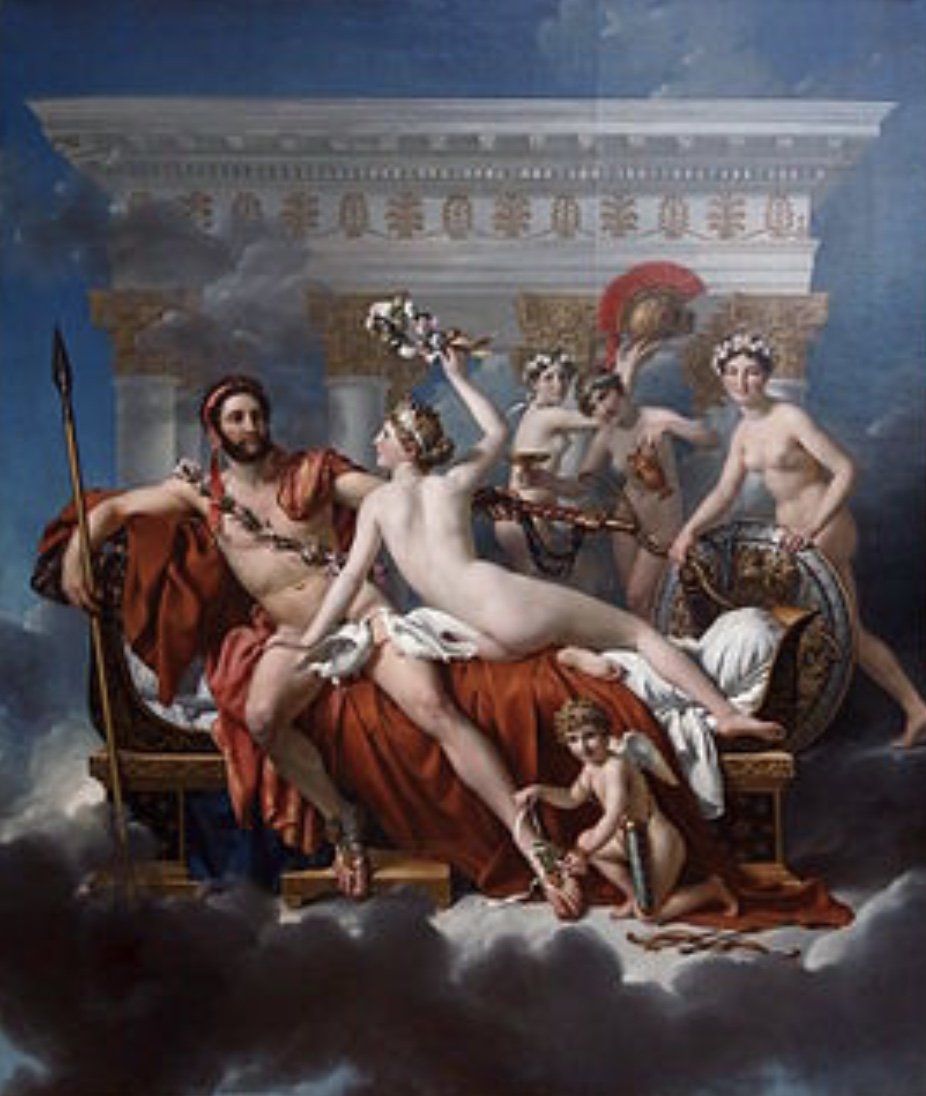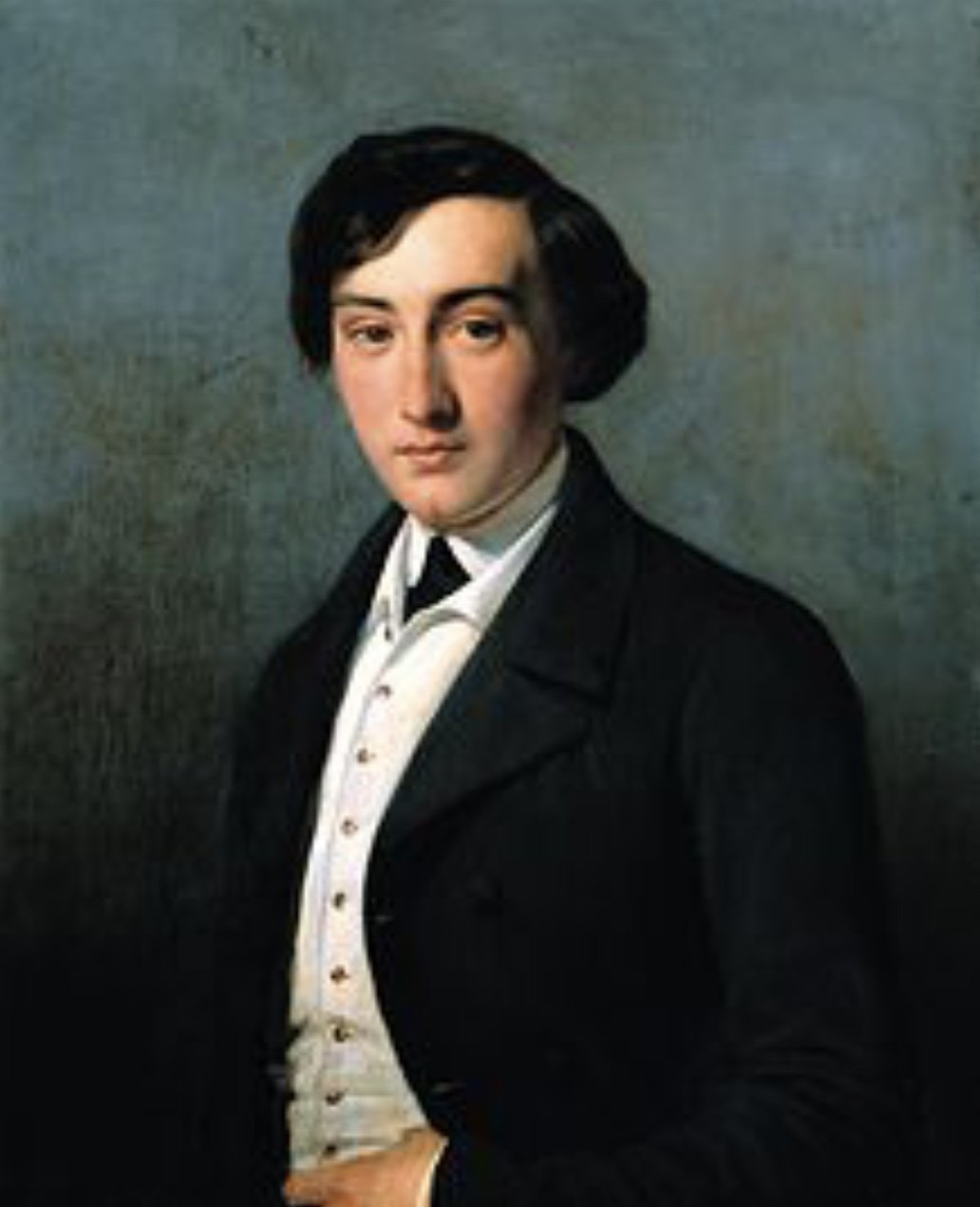Lucien Petipa as Jacques-Louis David’s Cupid
This (1), ten feet tall, was the last painting by the pre-eminent neoclassical artist Jacques-Louis David (1748-1825). I single it out here because the original model for its Cupid, kneeling in the foreground, was the fascinating Lucien Petipa (1815-1898). (The information identifying Lucien as David’s Cupid occurs in Nadine Meisner’s invaluable 2019 biography of Marius Petipa, Lucien’s younger brother.)
What was this Cupid to become? Lucien Petipa went on to be an outstanding danseur noble and eminent choreographer. He was the original Albrecht in “Giselle” (1841), the original Achmed in “La Péri” (1843), the original Lucien d’Hervilly in “Paquita” (1846); he created roles for the master-choreographers Monsieur Albert (“La Jolie Fille de Gand”), Jean Coralli (“La Péri”), Jules Perrot (“La Filleule des fées”), Joseph Mazilier (“Le Diable à quatre”); he partnered the ballerinas Carlotta Grisi, Fanny Cerrito, Adèle Dumilâtre, Sofia Fuoco, Adeline Plunkett, Carolina Rosati.
His career as choreographer included important premieres over almost thirty years. Probably he is not more celebrated in this respect because he composed the original scenarios for relatively few important ballets, the form of authorship that mattered most in the nineteenth century - though he was the author of “Sacountala” (1858), an Indian-themed ballet that surely helped to inspire his brother’s subsequent “La Bayadère” (1877), and “Namouna” (1882), whose glorious score by Édouard Lalo was subsequently to be choreographed by Serge Lifar (“Suite en blanc”) and Alexei Ratmansky (“Namouna, a Grand Divertissement”).
Lucien Petipa, however, was adept in choreographing ballets for operas. Because Paris was widely seen as the centre for opera, he therefore collaborated with many of the leading composers of the day: Charles Gounod for “La Nonne sanglante” (1854), Giuseppe Verdi for the world premiere of “Les Vêpres siciliennes” (1855 - its ballet, Verdi’s longest, was “Les Quatre Saisons”, choreographed by Kenneth MacMillan in 1975 and by Jerome Robbins in 1979 as “The Four Seasons”), Richard Wagner’s revised, Paris, 1861 production of his “Tannhäuser” (where Wagner and Petipa were not in accord), Verdi again for the world premiere of “Don Carlos” (1867, the “Ballet de la reine” choreographed in 1978 by George Balanchine as “Ballo della Regina”), and Ambrose Thomas for “Hamlet” (1868). In 1872-1873, he returned to Brussels, where his father had been leading dancer and ballet master at the time of this painting. He returned to Paris, however. In 1880, he became professor of pantomime at the Paris Opéra, in which capacity he ended his career. He died in his eighties at Versailles, having served the Opéra - the world’s most prestigious centre for opera and ballet - for most of his life.
I’ve often wished we knew ten times more of Lucien’s choreography. Since his brother Marius was successfully prosecuted in Paris for choreographic plagiarism, it’s at least possible that he stole choreographic ideas from his brother Lucien. Marius repeatedly visited Paris; Lucien is not known to have visited St Petersburg. Isn’t it at least possible that Lucien invented many of the choreographic features we now know from his brother’s Russian ballets? While Marius was collaborating with the hack composers Cesare Pugni and Ludwig Minkus, Lucien was at work with Ernest Reyer (“Sacountala”), Gounod, Verdi, Wagner, Thomas, and Lalo. He also choreographed the Paris Opéra’s first production (1860) of Rossini’s “Sémiramis”, at a time when the semi-retired Rossini had become the grand old man of Parisian music.
This painting belongs to the Museum of Fine Art in Brussels, Belgium: since 2007 (and since my last visit to Brussels) it has hung in the museum’s main hall. Jacques-Louis David, one of the foremost artists of the revolutionary and Napoleonic eras, ended his prestigious career in voluntary exile from France, declining an amnesty for his anti-Bourbon stance from Louis XVIII. The subject of Mars and Venus had long been a favourite of painters (London’s National Gallery has a famous version by Sandro Botticelli), but David, feeling it would be his final important painting, said “This is the last picture I want to paint, but I want to surpass myself in it. I will put the date of my seventy-five years on it and afterwards I will never again pick up my brush.” Most of his models for it were from Brussels’s Théâtre de la Monnaie. Nobody guessed then, however, that the cherubic Lucien Petipa - son to the Monnaie’s lead dancer and ballet master Jean Petipa, and already playing child roles onstage - would go on to shine in world ballet for decades to come.
Friday 1 July
@Alastair Macaulay 2022
1.Jacques-Louis David, “Mars désarmé par Vénus” (1822-1825). Lucien Petipa (1815-1898) is the Cupid in the foreground.
2: Louise Adélaïde Desnos, Lucien Petipa, 1849.
3: Lucien Petipa in old age: a professional photograph taken in Versailles, where he died in 1898.


